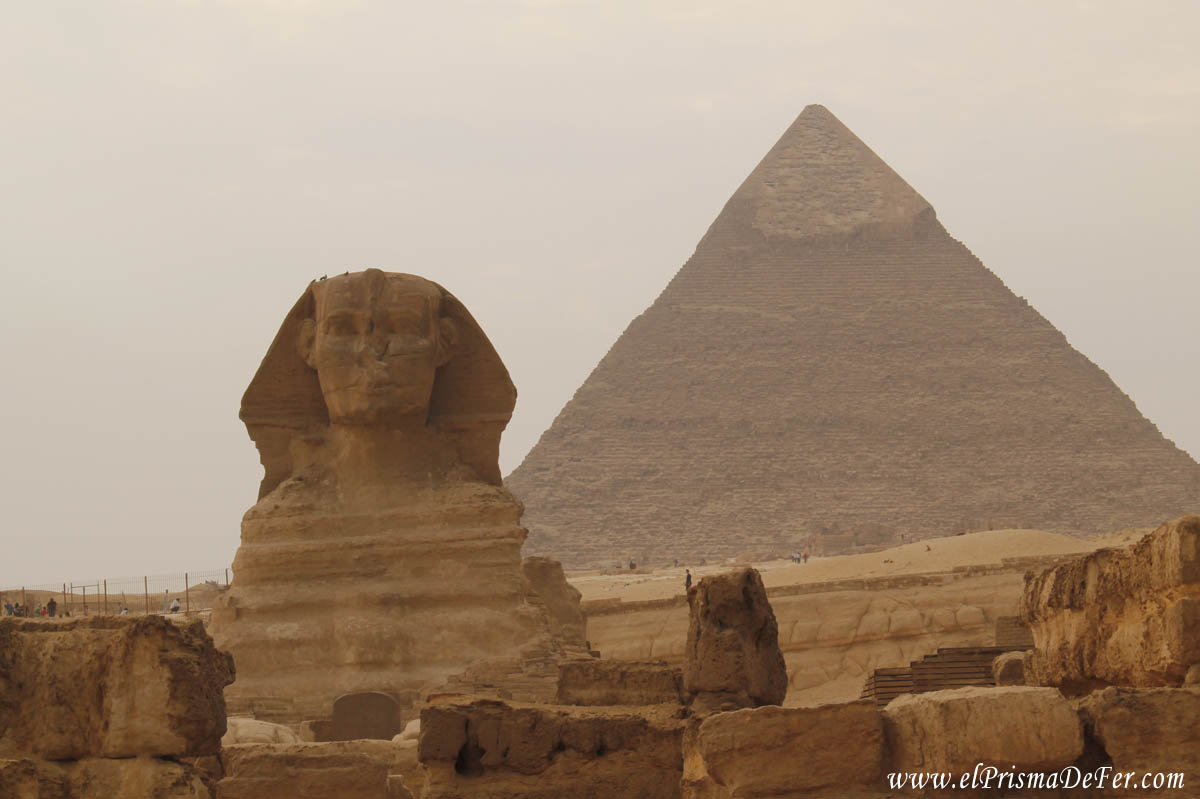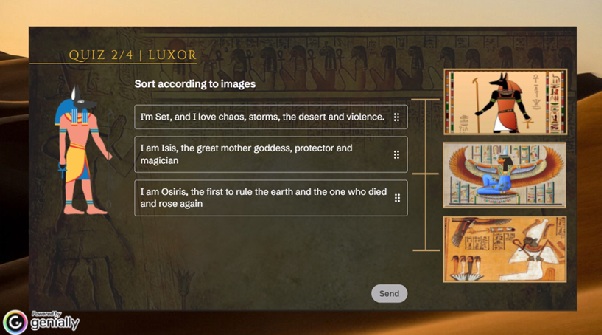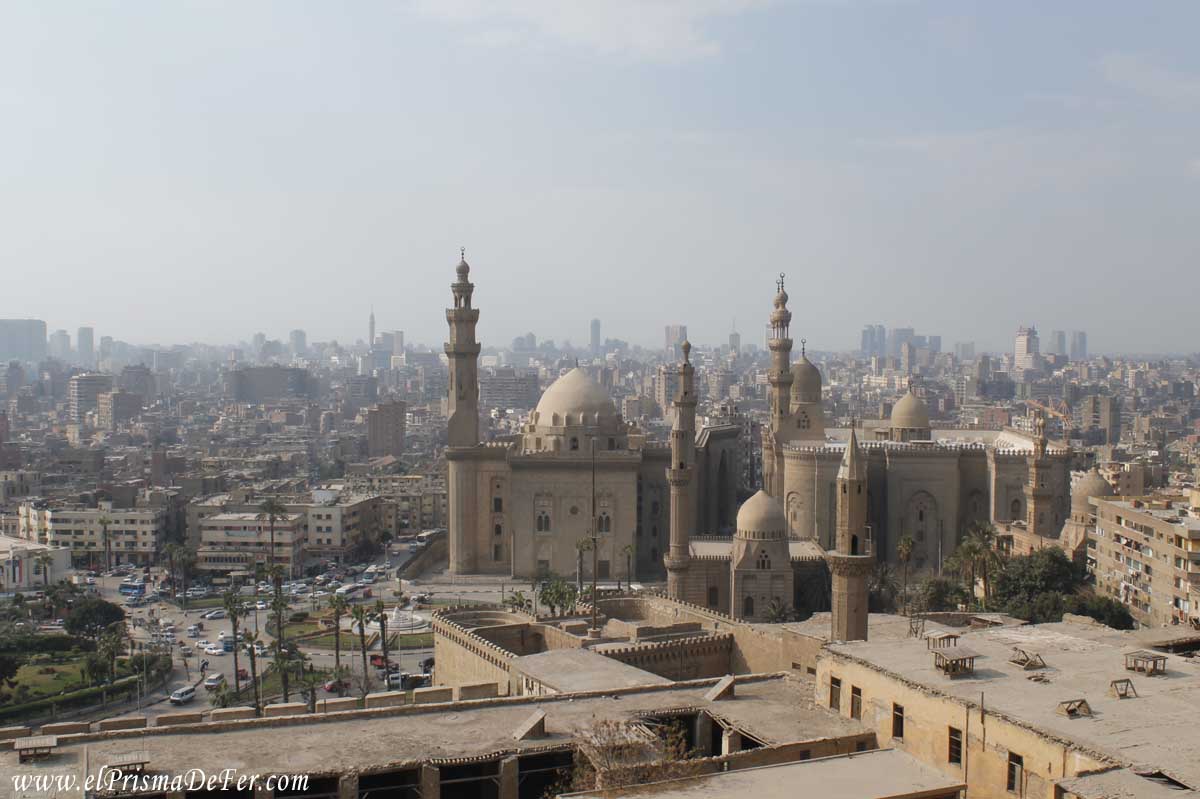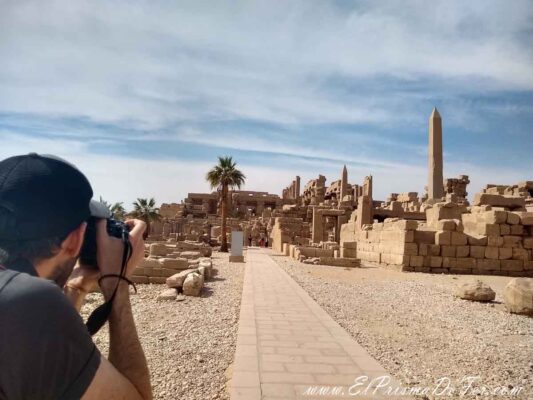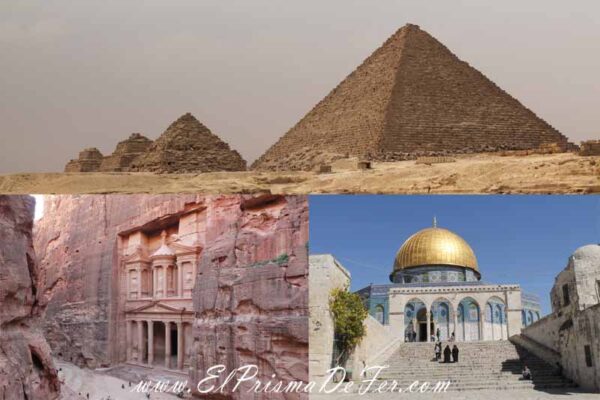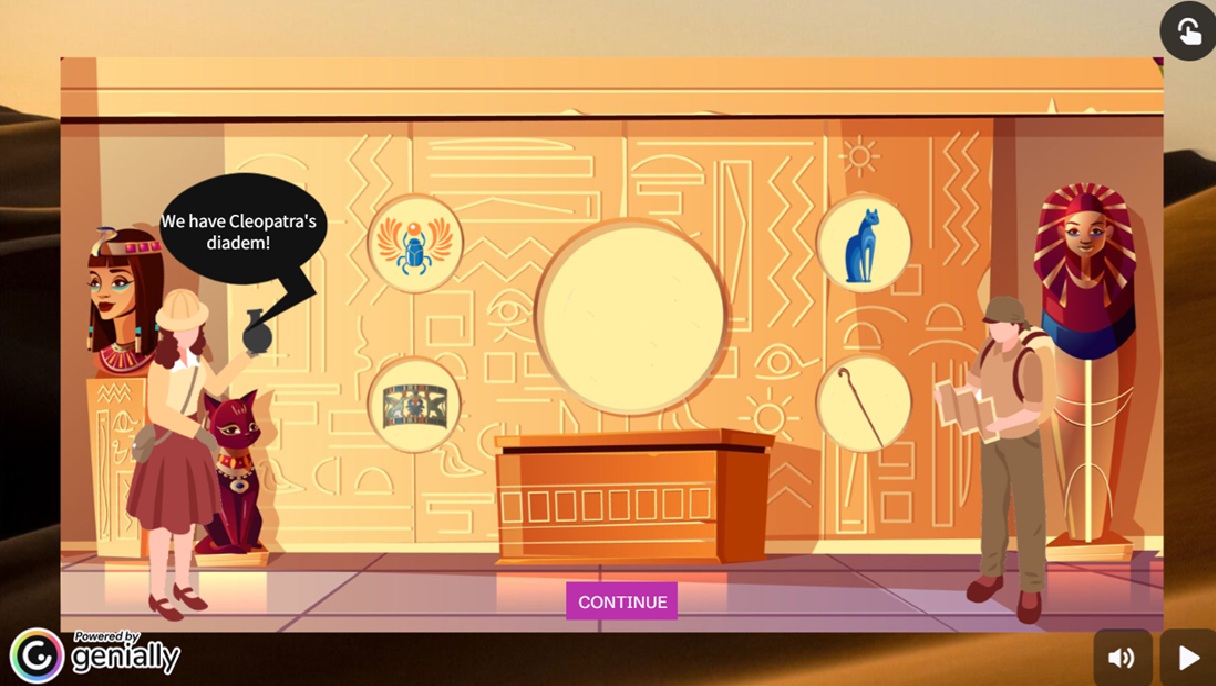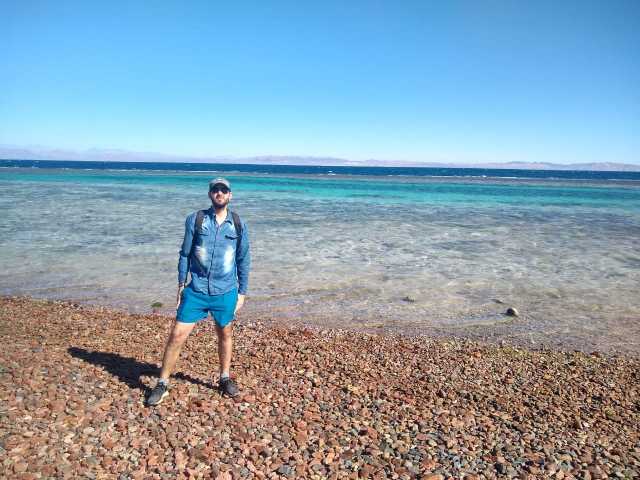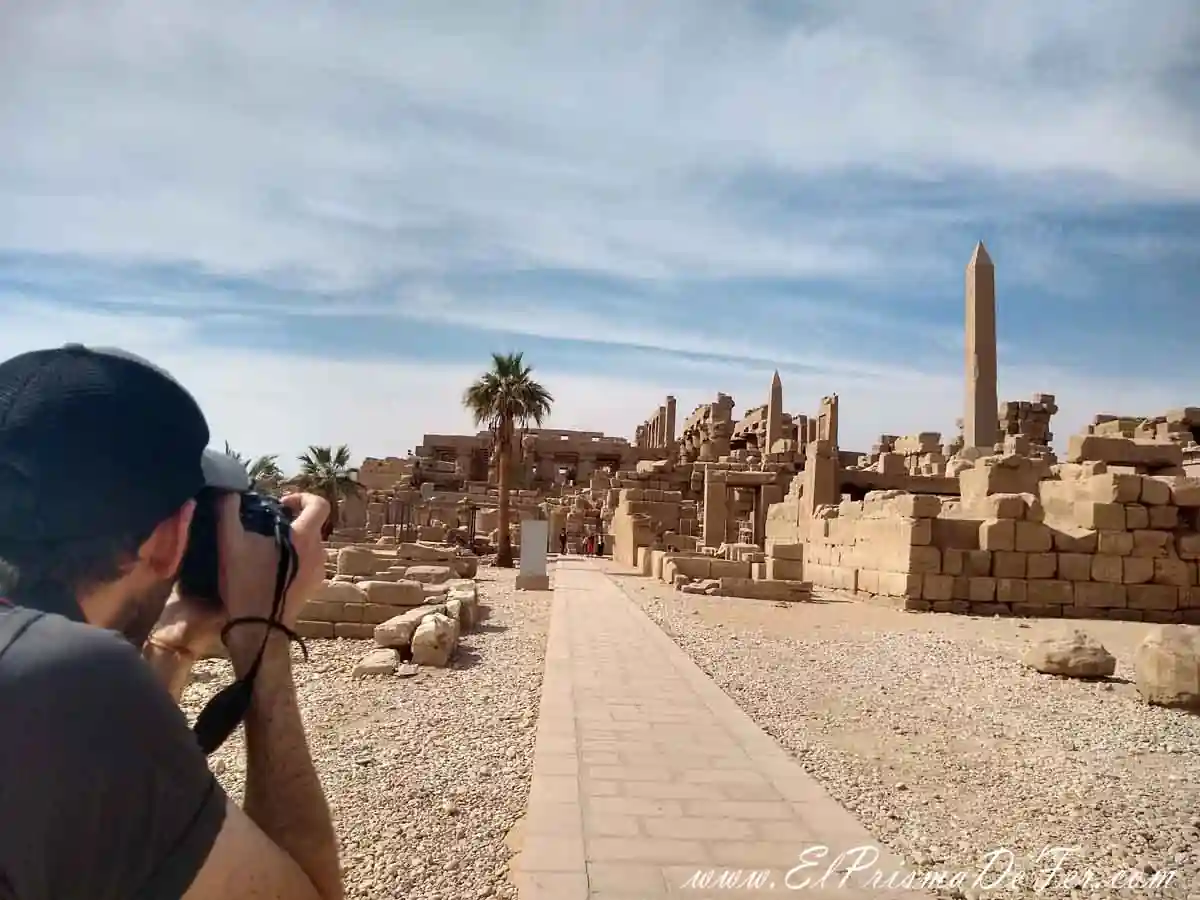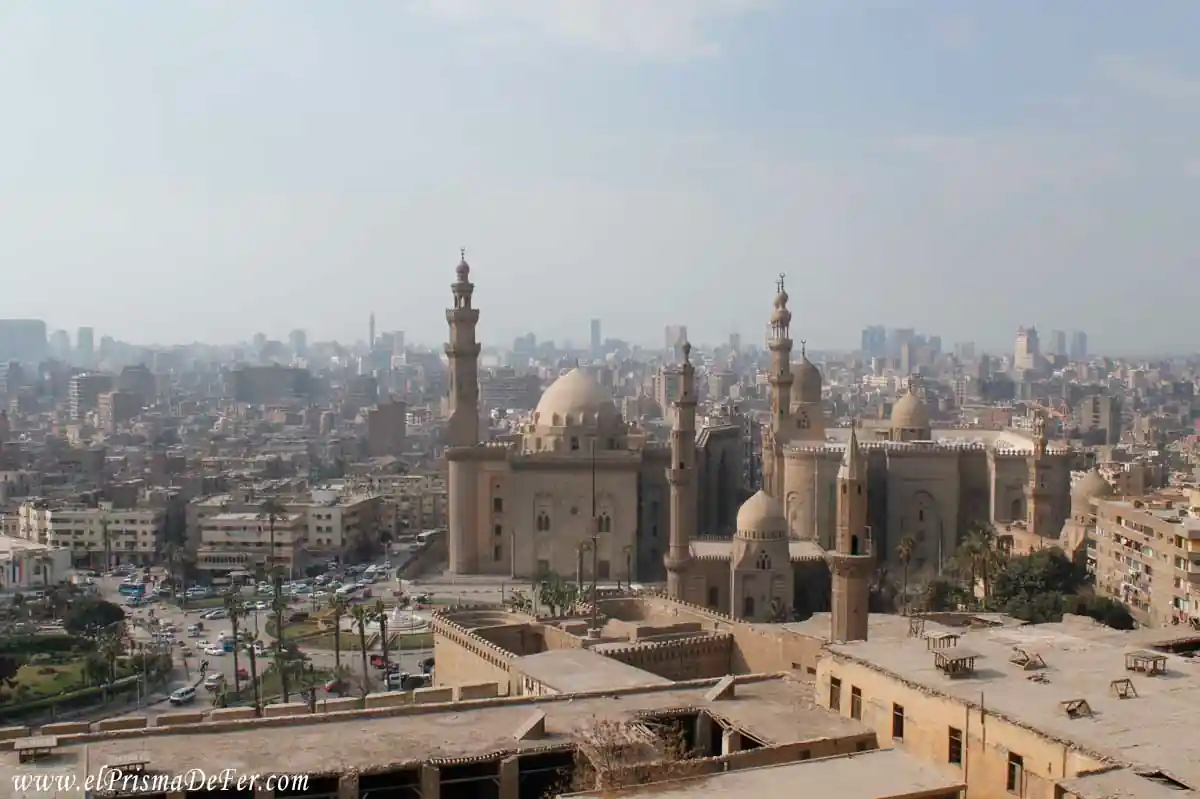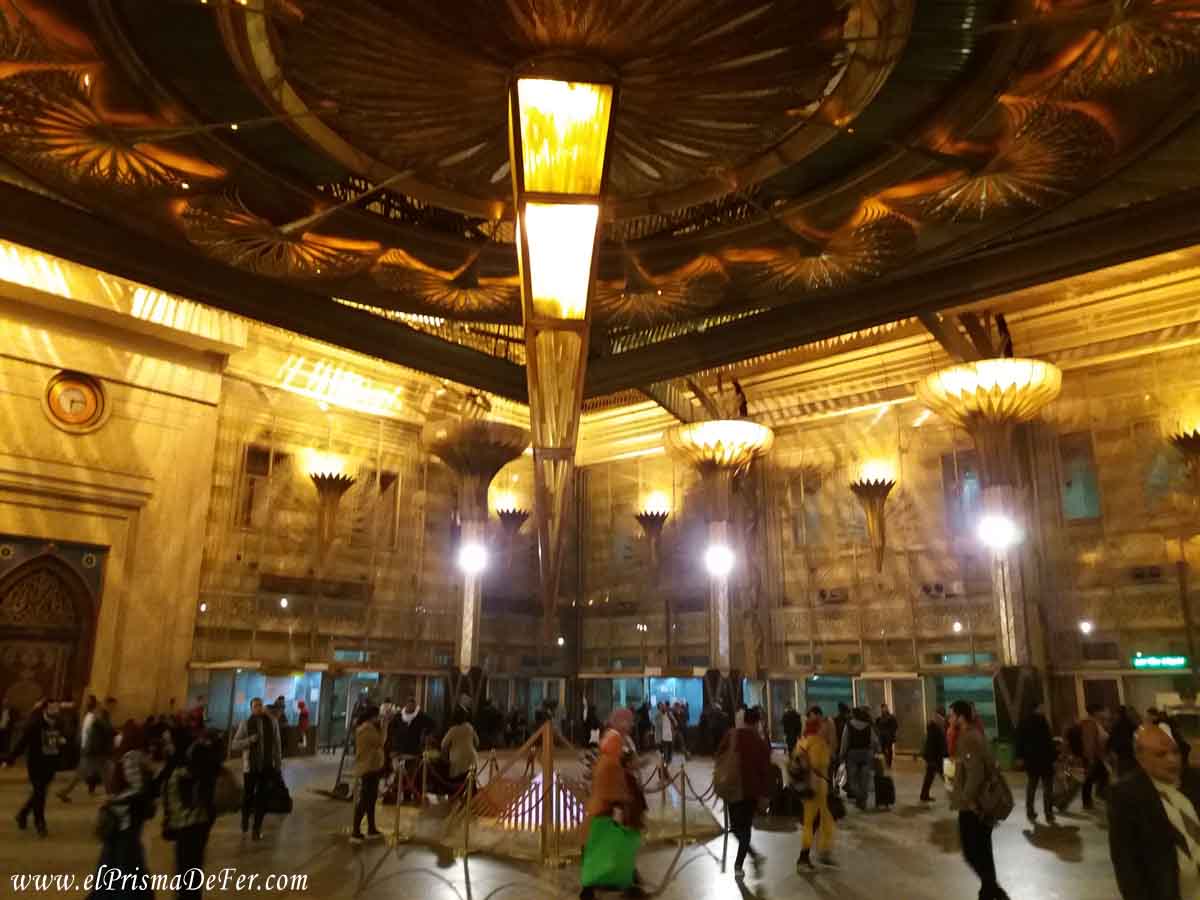🇪🇬 Egypt 🇪🇬 is one of those destinations that leave a lasting impression. Its historical legacy is simply immense: ancient pyramids, rock-carved temples, and tombs filled with mysteries that continue to fascinate the world. But beyond the traces of pharaohs and ancient gods, Egypt beats strongly in its present. Its vibrant Arab culture envelops travelers in a unique experience. In this practical guide to Egypt, you'll find an introduction to the lands of the Pharaohs, providing practical information that may be useful when planning your trip.
To learn more about visiting Egypt's tourist attractions, you can read their respective entries, where I describe, based on my experience, the things that surprised me and the temples and sites I consider essential to visit (they're at the end of the guide).
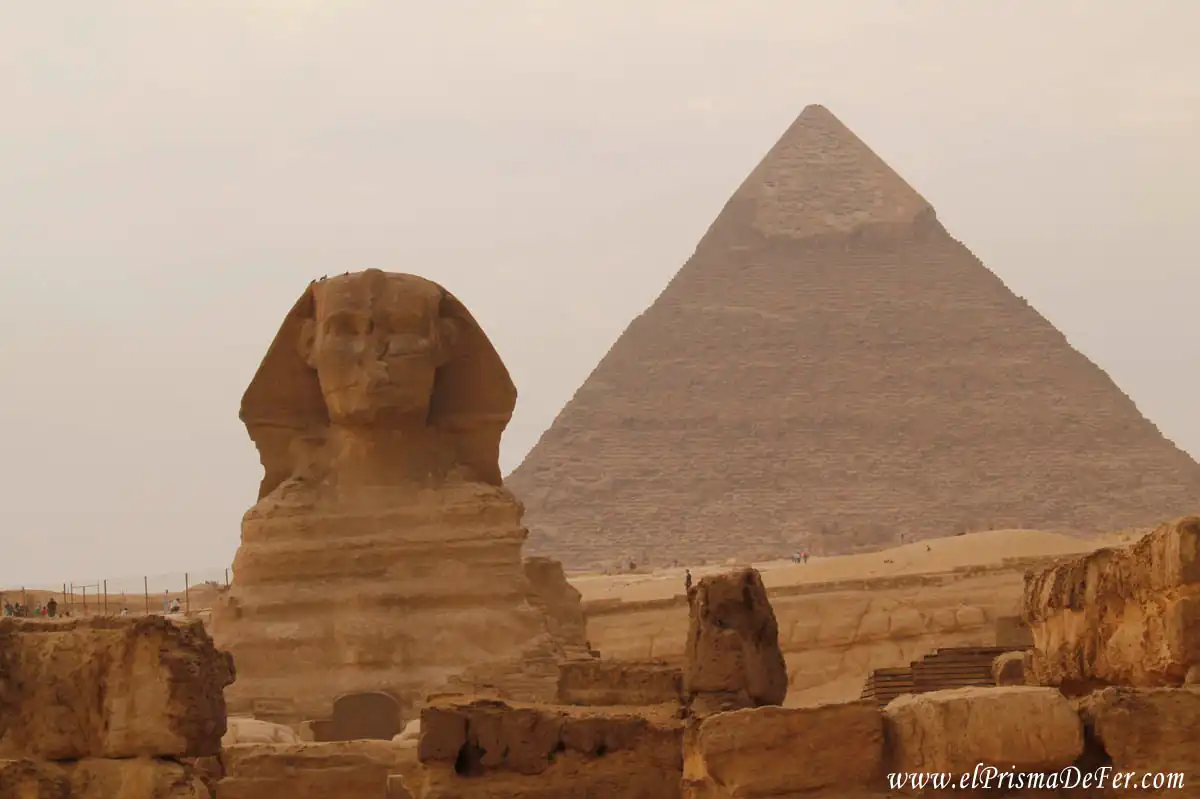

Table of Contents
What to know before traveling to Egypt
| Language 🗣️ |
| The official language is Arabic, although in tourist areas many speak basic English. |
| Currency 💵 |
| The Egyptian pound (EGP) is the official currency of Egypt |
| Religion ☪️ |
| Islam is the majority religion. It is important to respect local customs, especially in dress and when visiting religious sites. |
| Location 📍 |
| Egypt is located in northwest Africa |
| Capital 🏙️ |
| Cairo is the capital and most populous city in Africa, with almost 20 million inhabitants |
| Visa 🛂 |
| A visa is required to enter Egypt; it can be applied for online (e-visa) or upon arrival at the airport for many nationalities. |
Brief history of Egypt
Egypt is one of the oldest and most fascinating places in human history. Their civilization dates back more than 5,000 years, along the Nile Valley, where the first agricultural settlements emerged that would later give rise to a powerful centralized state. During the Old, Middle, and New Kingdoms, the pharaohs ruled with divine authority, building pyramids, temples, and monuments that continue to amaze the world today.
Over the centuries, Egypt was influenced by diverse cultures and conquerors: Greeks, Romans, Arabs, and Ottomans left their mark on its art, architecture, and daily life. The arrival of Islam in the 7th century transformed religion and society, giving rise to impressive mosques and madrasas that are now part of the heritage of Cairo and other cities.
Today, Egypt combines ancient history with modern urban life, where every corner tells stories of pharaohs, merchants, conquerors, and overlapping cultures, making it a must-see destination for those who love history and archaeology.
What are Arab men and women like in Egypt?
Before traveling to Egypt, we had read that men often give foreign women uncomfortable looks, even when they're accompanied. My ex-partner witnessed this from the plane to Egypt, and after walking just a few minutes through Cairo, he understood that these glances were going to be part of everyday life.
At least, in our experience, those looks weren't accompanied by shouting or inappropriate comments, something that was quite common in Buenos Aires until not long ago. What I can't say for sure is how they behave toward women traveling alone, as that wasn't the case with us.
Curiously, upon leaving the capital, we noticed a change. In cities like Aswan and Luxor, the lustful glances practically disappeared. There, my ex attracted more attention from the local women than from the men. Dressed in black robes that covered them from head to toe, many even with their hands covered and always veiled, they usually moved around in groups or with children, almost never alone.
In Cairo, however, it is noticeable that women are much more Westernized. Their dress is more relaxed, sometimes with modern, urban clothing, and this is also reflected in their jobs and attitudes: many are independent, running their own businesses, or studying and working outside the home. This creates an interesting contrast with other more conservative cities in the country.
I would have loved to talk to them, learn a little more about their world, and learn about their way of life. However, it wasn't possible: throughout the trip, we felt a certain distance, as if they preferred to avoid us or at least keep us at a distance. It's one of those unfinished business I'm left with from my time in Egypt.
How to get from Cairo Airport to the Center
To get from Cairo International Airport (CAI) to the city center, you have several options depending on your budget, comfort, and time available:
Official taxi or Uber/Careem
- White taxis: These are equipped with meters, but it's a good idea to confirm that they're activated before starting your trip.
- Uber and Careem: Reliable and popular ride-hailing apps in Cairo. You can request them upon arrival and pay in cash or by card.
- Estimated time: Between 30 and 60 minutes, depending on traffic.
- Approximate cost: Between 150 and 250 EGP (around 5 to 8 USD).
Public buses and BRT
- Internal Airport Shuttle: Connects the terminals with the airport bus station.
- From there: You can take public buses to key points such as Tahrir Square or the Abdel-Moniem Riad bus station.
- BRT (Bus Rapid Transit): A modern electric bus system that connects the airport to Adly Mansour Station, from where you can access other transportation lines.
- Cost: Very cheap (less than $1 USD), but may be less convenient if you have a lot of luggage.
Metro (line 3)
- Currently, the metro does not go directly to the airport.
- The nearest station is Adly Mansour, accessible by BRT or taxi.
- From there, you can connect to other metro lines to reach the city center.
How to move in Egypt
Inside the cities
Getting around Egypt isn't that complicated. In larger cities like Cairo, taxis, Uber, and the Metro are practical options (although traffic is chaotic and it often takes a long time to get from one side of the city to the other). There are also buses and small minivans, which are popular with locals, but they're usually crowded, no one understands English, and they don't clearly explain where they're going.
For longer trips, tourist buses and trains (especially between Cairo and Luxor) work well. In more rural areas, it's sometimes possible to arrange private transfers or join excursions.
Bus
The best-known bus companies are GoBu and BlueBud. They have affordable prices and cover routes to all major cities in Egypt, such as Cairo, Luxor, Aswan, Hurghada, Siwa, Alexandria, Sharm el-Sheikh, and Dahab.
Train
I wrote a post dedicated to explaining how the process of purchasing tickets from the website was and what it was like traveling by train from Cairo to Aswan.
Plane
Domestic flights are inexpensive. Egypt has its own flag carrier, Egypt Air, which has connections to most cities in the country, including Cairo, Alexandria, Luxor, Aswan, and Sharm el-Sheikh.
For example, I traveled by plane from Luxor to Sharm el-Sheik, and from there by taxi to Dahab. That trip took less than two hours and was reasonably priced, whereas if I had taken the bus, I would have had to return first to Cairo for a 12-hour trip, and then to Sharm el-Sheik for another eight hours (there is no direct bus). The amount of time saved is unparalleled.
What to see in Egypt?
There are many interesting sites to visit in Egypt. But among the most popular activities are:
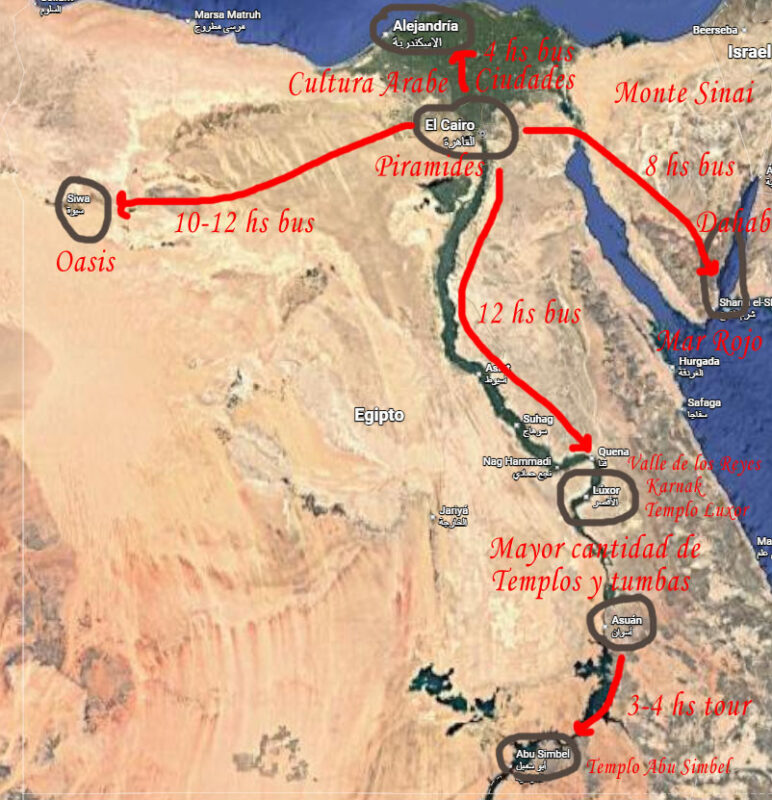
See the Pyramids of Giza

No trip to Egypt is complete without seeing the iconic Pyramids of Giza. These wonders of the ancient world, with over 4,500 years of history, impress not only with their size but also with the mystery that still surrounds them.
Although they're very close to Cairo, many hesitate between visiting them on their own or on a tour. In my case, the experience was bittersweet: getting to the Pyramids on my own was a real pain, and once there, the insistence of the vendors ended up making the visit quite exhausting. But they're still a marvel, and visiting them is a must.
Strolling through Cairo
Cairo is chaos, history, the scent of spices, and the sounds of every corner. The largest city in the Arab world invites you to explore its contrasts: from the grandeur of the Egyptian Museum to the daily life of its dusty streets. Getting lost in the Khan el-Khalili bazaar, one of the oldest in the world, is a must. Amidst alleyways filled with lamps, perfumes, jewelry, and textiles, every corner offers a story to discover.
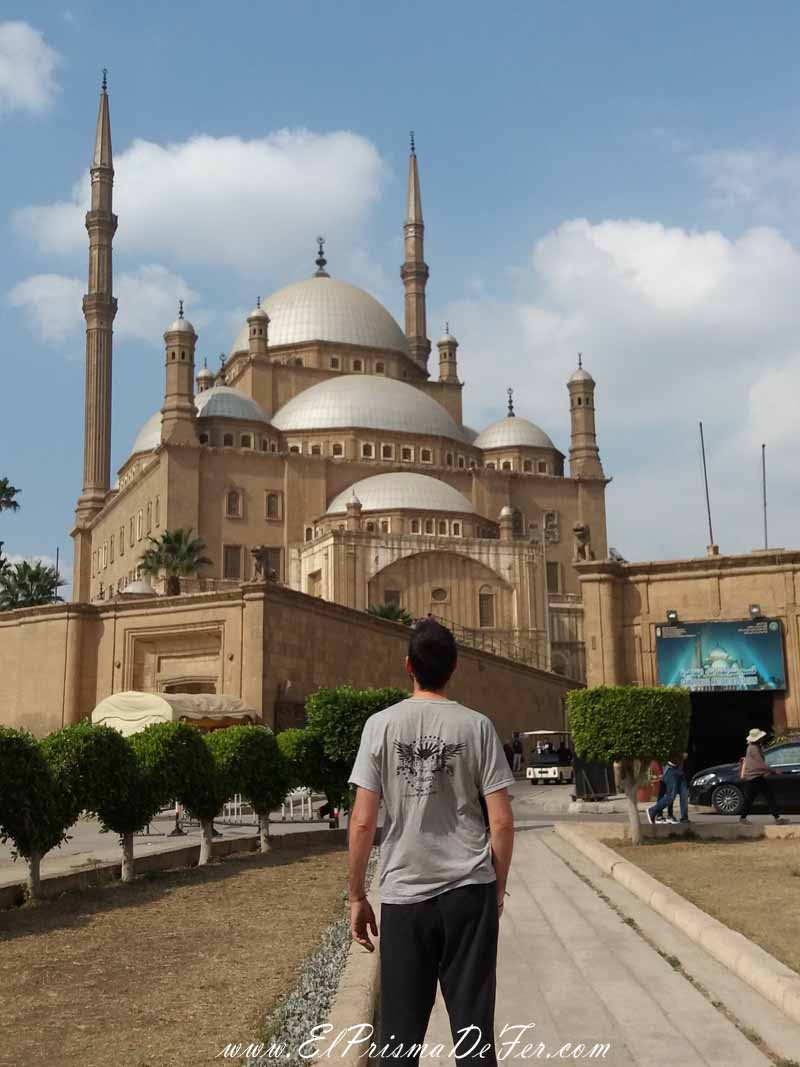
As must-sees, I recommend the Saladin Citadel and the Alabaster Mosque, one of the most beautiful in the world. Plus, from inside the complex, you can enjoy some of the most impressive views of Cairo.
Sailing on the Nile
The Nile is the soul of Egypt, and sailing it is almost a must for many. I didn't take the cruise, but I did take a few rides on the feluccas in Aswan. Regardless of how we choose to experience the Nile River, gliding along its waters magically connects us to the country. From the river, we have a different perspective of the world around us. It's a journey within a journey.
Explore ancient temples
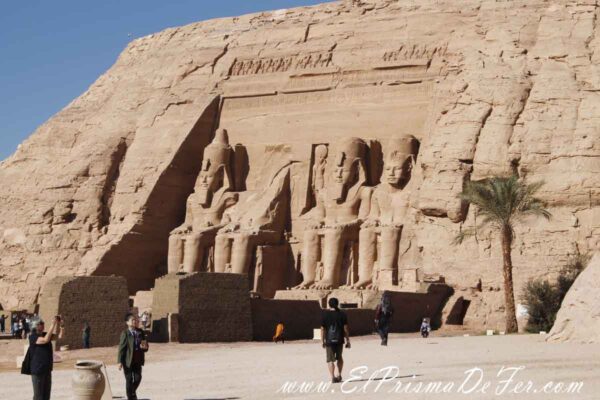
Egyptian temples are not just ruins: they are stone books open to the sky. Karnak, with its giant columns; Luxor, with its avenue of sphinxes; and Abu Simbel, with its colossi moved stone by stone to save them from the Nile, are examples of an art and ambition difficult to imagine today. Walking among ancient hieroglyphics and sacred passages is a little better understanding of the grandeur of a civilization obsessed with eternity.
Visit the Valley of the Kings

On the west bank of Luxor lies one of Egypt's most fascinating sites: the Valley of the Kings. The most powerful pharaohs rest here in tombs carved underground, decorated with scenes from the afterlife. Although many were looted in ancient times, the surviving art remains breathtaking. Entering the tomb of Tutankhamun or Ramses VI is like crossing the threshold into another world.
Relaxing in the Red Sea
After so much history and desert, nothing beats a few days of relaxation by the Red Sea. Its fine sandy beaches, warm waters, and coral reefs make it one of the best places in the world for snorkeling or diving. Hurghada and Sharm el-Sheikh offer resorts for all tastes, while Dahab is more chilled out and hippie. No matter where you are, the sea beckons you to explore.
Siwa, an otherworldly oasis
For those looking to escape the classic tourist routes, the Siwa Oasis is a hidden gem in the heart of the Egyptian desert. Famous for its endless dune landscapes, saltwater lakes, and unique Berber culture, Siwa offers a completely disconnected experience. Although I haven't had the opportunity to visit it personally, travelers who have been there highlight the friendliness of its people, the sunsets over the Great Sand Sea, and the magic of its ancient ruins like the Oracle of Amun. Ideal for adventurous spirits and lovers of remote places.
Alexandria, the Mediterranean air of Egypt
I didn't have time to explore Alexandria either, but that's another plan if you're looking for a Mediterranean atmosphere with a fascinating history. Founded by Alexander the Great, this coastal city invites you to stroll among fortresses, museums, and the famous Library of Alexandria, a modern symbol of its intellectual past. It's a perfect destination for those seeking history, culture, and a sea breeze.
What are hieroglyphics?
- Hieroglyphics aren't just "little pictures." Each symbol has a precise meaning: it can be a sound (like a letter), a complete word, or an idea. It's not a "picture" language, as we often think of it.
- They are read in different directions: Hieroglyphics can be read from left to right, right to left, or top to bottom. Observe which way the human or animal figures are facing, and that is the direction they should be read.
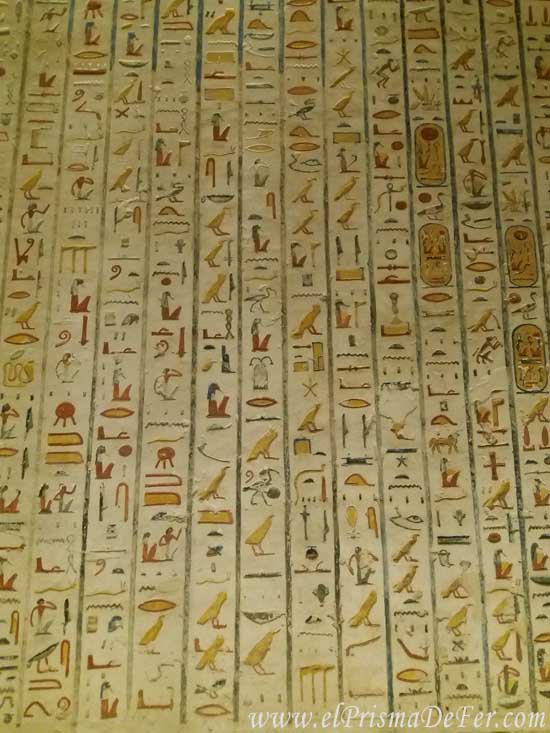
- There are symbols that are phonetic and others that are ideograms: Some hieroglyphs represent sounds (like letters), and others represent concepts (for example, the sun means “sun” directly).
- Cartouches: Royal names: When you see a closed oval enclosing hieroglyphics (cartouche), it means that the name of a pharaoh or queen is written there.
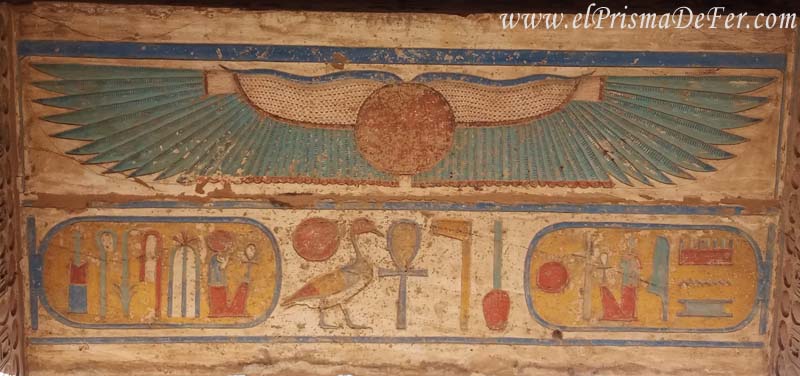
- Symbolic colors: Colors also conveyed messages: green represented fertility, blue the Nile or the sky, red strength or chaos.
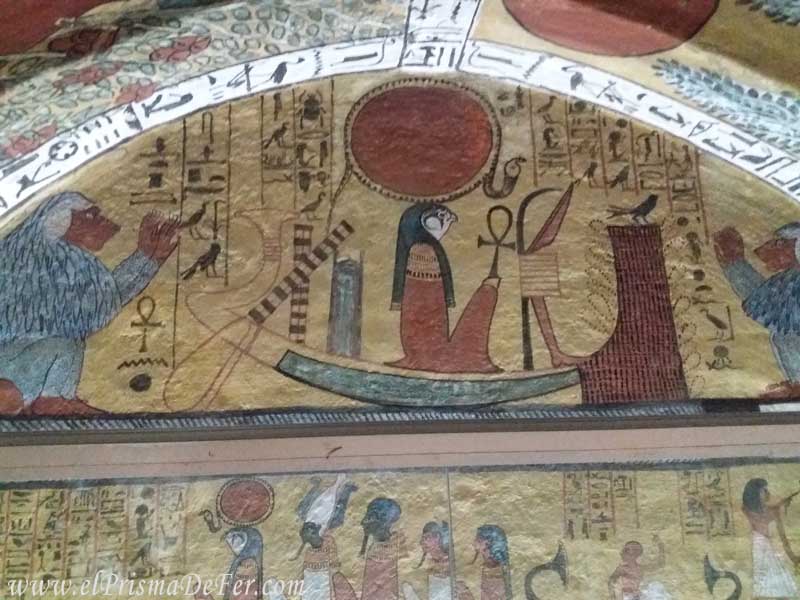
- They are a form of eternity: The Egyptians believed that if a name was erased, that person ceased to exist in the afterlife. That's why temples and tombs are so full of inscribed names.
- You don't need to understand everything: Enjoy the aesthetics, look for cartouches, animals, figures of gods (like Anubis or Horus) and let yourself be carried away by the sensation of reading messages from thousands of years ago.
Guide to understanding hieroglyphics
1. Anj (☥)
- Meaning: “Eternal life”
- Where to see it: In almost every temple; many gods hold it in their hands.
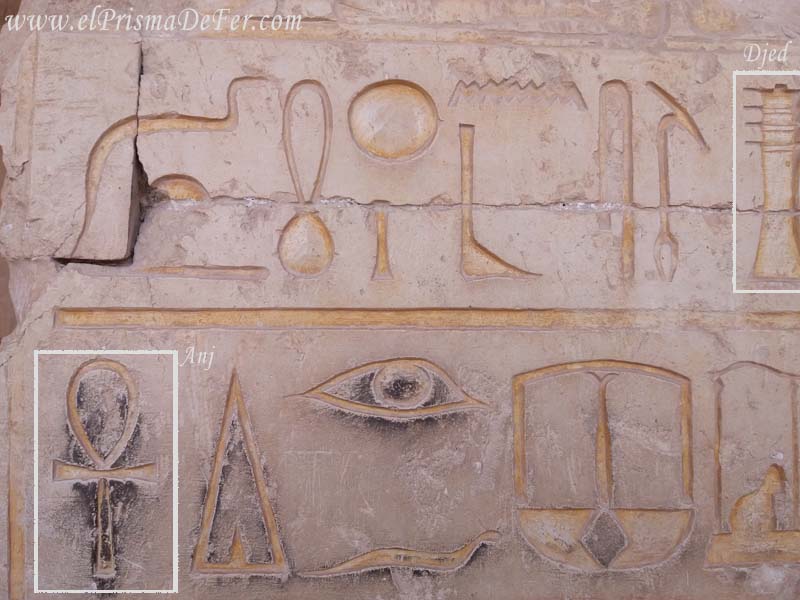
2. Djed
- Meaning: “Stability”
- Where to see it: Associated with the god Osiris, it often appears as a pillar with horizontal stripes.
3. Cartridge (elongated oval)
- Meaning: It contains the name of a pharaoh or queen.
- Where to see it: On columns, walls, and royal statues.
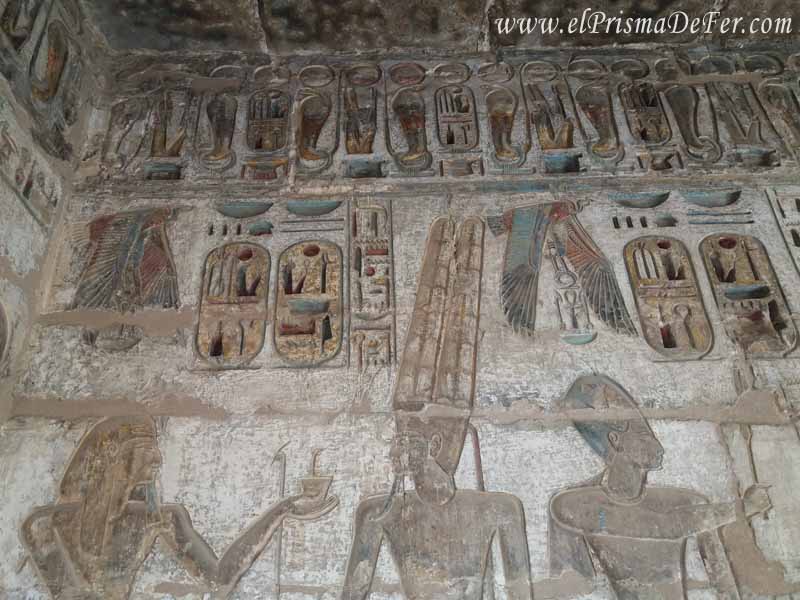
4. Nile (water waves symbol: ≋)
- Meaning: It represents water, especially the Nile River.
- Where to see it: Agricultural frescoes and navigation scenes.
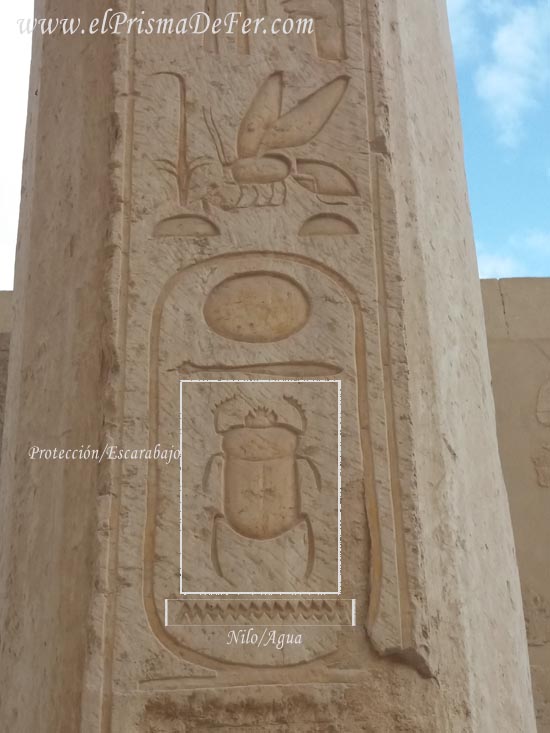
5. Beetle (dung beetle)
- Meaning: “Rebirth” and “protection”.
- Where to see it: Lots of jewelry, tombs, and amulets.
6. Feather of Maat
- Meaning: “Truth and justice”.
- Where to see it: Judgment scenes from the Book of the Dead or the Judgment of Osiris.
7. Owl
- Meaning: “M” sound
- Where to see it: Inside phonetic inscriptions (when you see a little owl it's because it's part of a word).
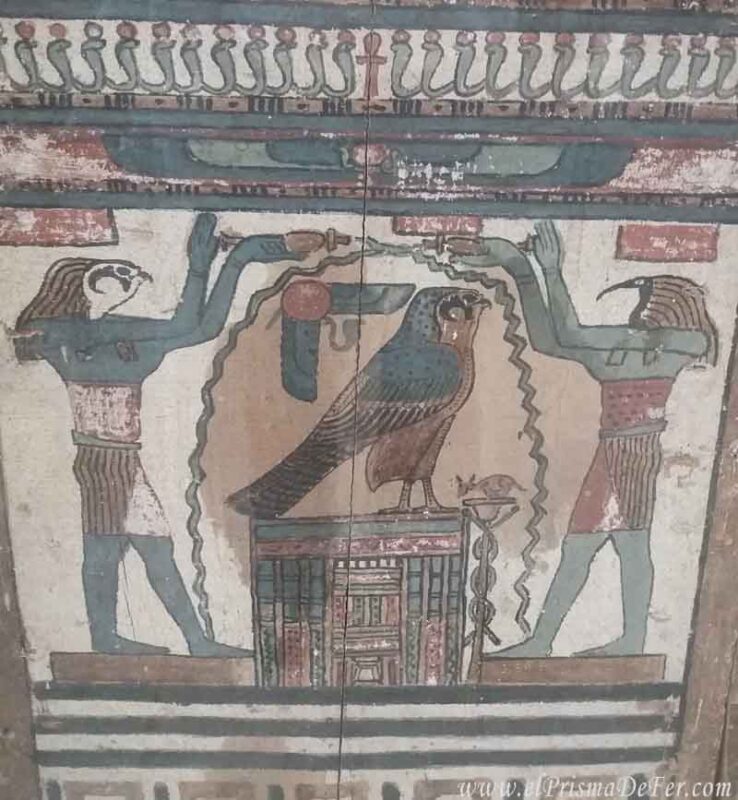
8. Cane and half-cane
- Meaning: They usually represent “T” and “I” sounds (basic for forming words).

Typical Egyptian foods
Egyptian cuisine is delicious and affordable. Don't miss koshari (a street dish made with rice, lentils, and noodles), ful medames (fava bean puree), shawarma, and falafel. For those looking for something sweet, basbousa (semolina cake) is a classic. Eating in Egypt is also a way of understanding their daily life.

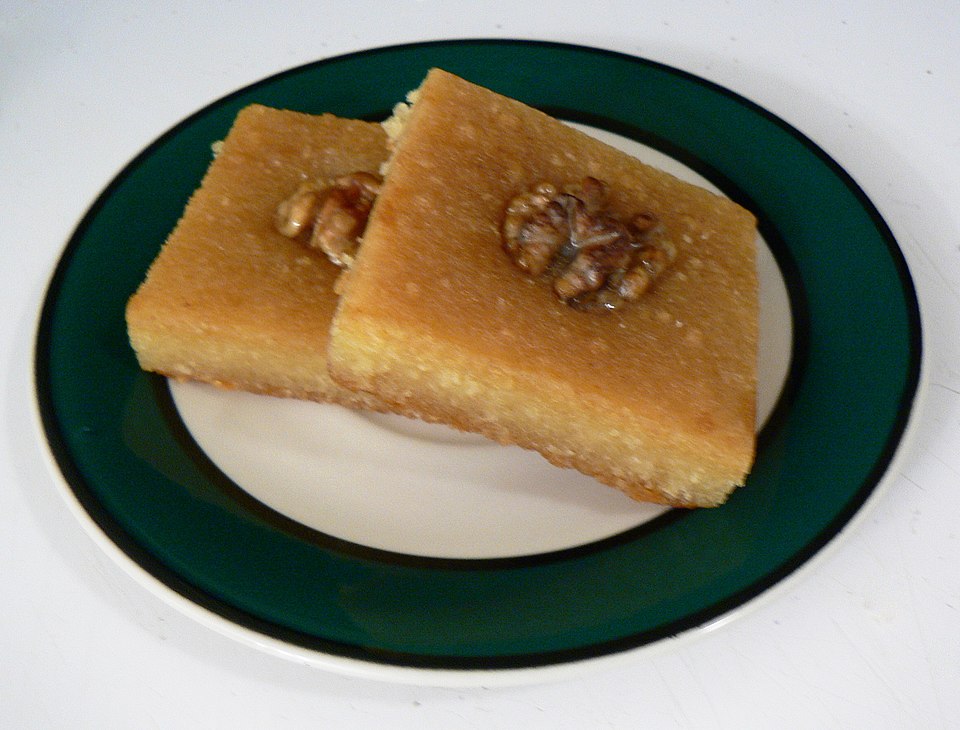
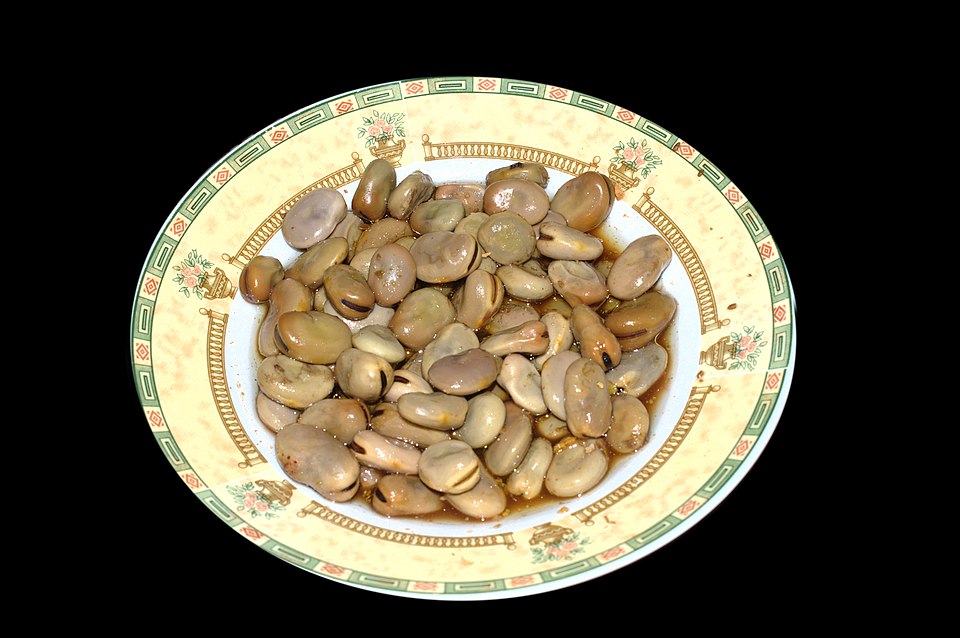
Best time to go to Egypt
The best time to travel to Egypt is between October and April, when temperatures are milder (between 20°C and 30°C). In summer (May to September), the heat is extreme, especially in places like Luxor or Aswan, where it can exceed 45°C. If you want to enjoy the temples and the desert without overheating, choose the winter months.
Is it safe to go to Egypt?
Egypt is generally safe for tourism, especially in areas like Cairo, Luxor, Aswan, and the Red Sea resorts. However, be careful with your belongings, avoid protests, and always follow local advice. In more isolated areas of the desert or Sinai, it's a good idea to check official recommendations first. And in Cairo, especially at night, there may be areas that don't feel very safe.
Is Egypt expensive?
Egypt is a fairly affordable destination compared to Europe or America. Admission to monuments and temples can add up quickly (especially if you visit several in one day), but accommodation, food, and local transportation are cheap. You can travel comfortably on a mid-range budget, and even more so if you're backpacking.
Which SIM card should I use in Egypt?
In Egypt, there are four major mobile operators offering SIM cards for tourists, all with good coverage across most of the country, including areas like the desert and Upper Egypt.
Whichever option you choose, try to buy the SIM card from an official store so they can activate it immediately and avoid any problems. You'll need to present your passport to purchase it.
1. Vodafone Egypt
- The most popular among travelers due to its good coverage, even in tourist areas like Luxor, Aswan, or the desert.
- It has very affordable data packages: for example, 8–10 GB for around 100–150 EGP (~3–5 USD).
- Available at Cairo Airport, official stores, and stalls around the city.
2. Orange Egypt
- Good coverage, especially in large cities like Cairo or Alexandria.
- Tourist plans available with data + minutes combos.
- Prices similar to Vodafone, although in rural areas there may be weaker signal.
3. Etisalat Misr
- Strong third competitor, with solid coverage in urban areas.
- Their plans usually have more gigabytes for the same price, but less coverage in the south.
4. WE (Telecom Egypt)
- New compared to the others, but growing.
- It offers affordable packages and good speed in cities.
- Not yet recommended if you are going to remote areas.
If you do not want to complicate your life with a traditional Sim, and your mobile accepts eSim, you can buy one from the operator Airalo through this link offered by the company Civitatis.
What to do in Egypt in 7 and 14 days
Tentative 7-day itinerary in Egypt:
If it's your first time visiting Egypt, and you only have 7 days to get to know it, my tentative itinerary would be this:
- Day 1: Arrival in Cairo
- Day 2: Cairo (Egyptian Museum, Khan el-Khalili Bazaar, Saladin Citadel)
- Day 3: Cairo (Giza Pyramids, Sphinx, and Saqqara); overnight train to Luxor or fly the next day.
- Day 4: Luxor (Karnak Temple and Luxor Temple)
- Day 5: Luxor (West Bank of the Nile River: Valley of the Kings, Deir el-Medina, Hatshepsut, Ramesseus II)
- Day 6: Luxor (relax and discover lesser-known sites like the Valley of the Queens, Medinet Habu Temples, coffee by the Nile, or take a sunset felucca ride)
- Day 7: Return to Cairo
If you want to prioritize visiting temples and don't mind rushing around, I would subtract 1 day from the 7-day itinerary above and add Aswan.
- Day 1: Arrival in Cairo
- Day 2: Cairo (Giza Pyramids, Sphinx and Saqqara);
- Day 3: Cairo -> Aswan by plane
- Day 4: Aswan – Abu Simbel Temple
- Day 5: Luxor (Karnak Temple and Luxor Temple)
- Day 6: Luxor (West Bank of the Nile River: Valley of the Kings, Deir el-Medina, Hatshepsut, Ramesseus II)
- Day 7: Return to Cairo
Tentative 14-day itinerary in Egypt:
With 14 days, you can explore more leisurely. I'd add days in the Siwa Oasis or Alexandria, take a cruise on the Nile River, or include the Red Sea region.
- Day 1: Arrival in Cairo
- Day 2: Pyramids of Giza, Sphinx, and Saqqara
- Día 3: Museo Egipcio y Ciudadela de Saladino en El Cairo
- Day 4: Alexandria (round trip or overnight)
- Day 5: Flight or train to Aswan
- Day 6: Aswan: Philae Temple and Felucca Ride
- Day 7: Aswan and Abu Simbel excursion
- Day 8: Nile cruise (start: Aswan – Kom Ombo)
- Day 9: Nile Cruise (Edfu – arrival in Luxor)
- Day 10: Luxor: West Bank (Valley of the Kings and Hatshepsut)
- Day 11: Luxor: Karnak and Luxor Temple
- Day 12: Transfer to Hurghada (Red Sea)
- Day 13: Hurghada: Relaxation and snorkeling in the Red Sea
- Day 14: Return to Cairo and departure flight
Support The Prism of Fer!
Your support helps me continue creating free content on the blog. Thank you so much!


